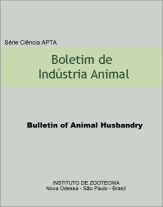CHEMICAL CHARACTERIZATION OF BRANCH SILAGE OF CASSAVA CULTIVARS WITH OR WITHOUT PRE-DRYING
DOI:
https://doi.org/10.17523/bia.v74n3p176Keywords:
ensiling, Manihot esculenta, pre-dried, nutritional quality.Abstract
The objective of this study was to evaluate the storage and nutritional quality of ensiled branch of cassava cultivars Pão and IAC 7650 and the influence of pre-drying. The following treatments were evaluated: SPSD, ensiling of branch of cassava cv. Pão; SPD, ensiling of pre-dried branch of cassava cv. Pão; SISD, ensiling of branch of cassava cv. IAC 7650; SID, ensiling of predried branch of cassava cv. IAC 7650. A completely randomized design with or without pre-drying and four replicates was used. The pH and buffering capacity were determined for the evaluation of silage storage, and dry matter, organic matter, mineral matter, crude protein (CP), acid detergent fiber (ADF) and neutral detergent fiber (NDF) content for the assessment of nutritional quality. Both cultivars exhibited characteristics for the use of branch as silage after pre-drying. The highest content of partial and total dry matter was observed for the IAC 7650 cultivar after the period of drying and no significant difference (P>0.05) was found in fibrous content. Regarding silage quality, the buffering capacity was influenced (P<0.05) by the dehydration process, while pH ranged from 3.93 to 4.43. Highest values of total dry matter content were found for silage after drying process.. Crude protein content was higher in silage of the Pão cultivar and pre-drying exerted no significant influence (P>0.05). A lower NDF content was observed in SPSD, while there was no significant difference in ADF content (P>0.05). Dehydration of the branch of cassava is efficient in controlling the buffering capacity of the two cultivars and the pH obtained is adequate. The nutritional value continued satisfactory even after dehydration, with a higher protein content in the Pão cultivar.Downloads
Downloads
Published
Issue
Section
License
Os autores não serão remunerados pela publicação de trabalhos, pois devem abrir mão de seus direitos autorais em favor deste periódico. Por outro lado, os autores ficam autorizados a publicar seus artigos, simultaneamente, em repositórios da instituição de sua origem, desde que citada a fonte da publicação original seja Boletim de Indústria Animal. A revista se reserva o direito de efetuar, nos originais, alterações de ordem normativa, ortográfica e gramatical, com vistas a manter o padrão culto da língua e a credibilidade do veículo. Respeitará, no entanto, o estilo de escrever dos autores. Alterações, correções ou sugestões de ordem conceitual serão encaminhadas aos autores, quando necessário. Nesses casos, os artigos, depois de adequados, deverão ser submetidos a nova apreciação. As opiniões emitidas pelos autores dos artigos são de sua exclusiva responsabilidade. Todo o conteúdo deste periódico, exceto onde está identificado, está licenciado sob a Licença Creative Commons Attribution (CC-BY-NC). A condição BY implica que os licenciados podem copiar, distribuir, exibir e executar a obra e fazer trabalhos derivados com base em que só se dão o autor ou licenciante os créditos na forma especificada por estes. A cláusula NC significa que os licenciados podem copiar, distribuir, exibir e executar a obra e fazer trabalhos derivados com base apenas para fins não comerciais.













